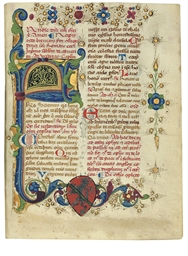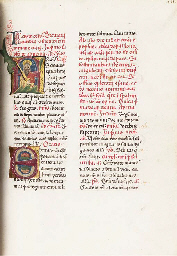BREVIARY, use of Rome, in Latin, ILLUMINATED MANUSCRIPT ON VELLUM [Lombardy, 1450-60]205 x 148mm. 454 leaves: 1 6, 2-17 8, 18 4, 19-23 8, 24 6, 25-40 8, 41 9(of 8 +i blank), 42-44 8, 45 7(of 8, viii cancelled blank), 46-53 8, 54 6, 55-57 1 0, 58 2 (lacking one gathering, with signature rr after f.312), catchwords in centre of lower margins of final versos, many signatures, 30 lines written in brown or black ink in gothic bookhands in two columns between four verticals ruled by point and 31 horizontals ruled in brown, justification: 128 x 47-10-44mm, rubrics in red, blue paraphs, one-line initials alternately red or blue in Psalter ff.353-421 (blue initials not supplied on all leaves), two-line initials alternately red or blue (blue initials not supplied ff.185-352), nine large initials with maroon staves on liquid gold grounds with red and green acanthus infills spiking into the margin (most incomplete), NINE HISTORIATED INITIALS ON BURNISHED GOLD GROUNDS (one incomplete), with pink or maroon staves leading to red and green acanthus leaves in the margin, one with full border of red, blue, green and purple acanthus and burnished gold stars and disks, not all large initials supplied (slight wear to margins, some leaves cockled). 19th-century brown calf preserving Italian c.1500 blind-stamped sides. PROVENANCE: The Breviary was probably commissioned by someone associated with Sant'Agostino, the house of Augustinian Hermits, in Como. The shield on f.7 was never completed. The Calendar includes many saints revered in Como, including, in red, Liberata and Faustina (18 Jan), whose relics were in Como, and Probinus (8 March) and Abondius (2 April), both bishops of Como; five other canonised bishops of Como are celebrated in black; also in red are the feasts of St Augustine (28 Aug), his two translations (28 Feb and 11 Oct), his mother Monica (9 April), her translation (4 May) and St Nicolas of Tolentino 'of the Order of Hermits' (10 Sept) with octave. The Temporal of the Breviary is stated to be of Roman Use, as are the Offices of the Virgin and of the Dead; the Sanctoral does not contain all the local feasts of the Calendar and honours St Francis as well as St Augustine as 'our father'. Additional feasts placed out of order at the end of the Sanctoral include the Franciscan St Louis of Toulouse as well as Monica, Augustine's conversion, Nicolas of Tolentino and William the Hermit, whose Order had been absorbed into the Augustinians. Nicolas was canonised in 1446 and the book was probably produced soon afterwards. CONTENT: Calendar ff.1-6; Temporal, use of Rome, from the first Saturday in Advent to the fourth Sunday in November ff.7-184; Sanctoral from Saturnin (29 Nov) to Catherine (25 Nov), followed by additional feasts (lacking the end of the office of Sts Cornelius and Cyprian (14 Sept), through to the beginning of St Francis (4 Oct), contained in one gathering lacking after f.312), ff.185-352; ferial Psalter ff.346-409; Hymnal ff.409v-421; blank f.422; Communal ff.423-443v; Office of the Virgin, use of Rome,ff.443v-447; Office of the Dead, use of Rome, ff.447-449v; rubrics from Advent ff.449v-453; blank ff.453v-454. ILLUMINATION: The clear, bright palette -- combining saturated tones of green, blue, red and magenta -- and small-featured doll-like figures are absolutely characteristic of the highly decorative and engaging style of illumination that dominated Lombard manuscript production throughout the first three-quarters of the 15th century. Although the foliage forms and technique are deeply indebted to the Master of the Vitae Imperatorum there is no need for this manuscript to have been illuminated in Milan itself; it may have been produced locally by an illuminator active in Como. The incomplete states of one of the historiated and several of the large foliate initials give an interesting demonstration of the stages of work involved in bringing illumination to completion. The large initials come at the divisions of th
BREVIARY, use of Rome, in Latin, ILLUMINATED MANUSCRIPT ON VELLUM [Lombardy, 1450-60]205 x 148mm. 454 leaves: 1 6, 2-17 8, 18 4, 19-23 8, 24 6, 25-40 8, 41 9(of 8 +i blank), 42-44 8, 45 7(of 8, viii cancelled blank), 46-53 8, 54 6, 55-57 1 0, 58 2 (lacking one gathering, with signature rr after f.312), catchwords in centre of lower margins of final versos, many signatures, 30 lines written in brown or black ink in gothic bookhands in two columns between four verticals ruled by point and 31 horizontals ruled in brown, justification: 128 x 47-10-44mm, rubrics in red, blue paraphs, one-line initials alternately red or blue in Psalter ff.353-421 (blue initials not supplied on all leaves), two-line initials alternately red or blue (blue initials not supplied ff.185-352), nine large initials with maroon staves on liquid gold grounds with red and green acanthus infills spiking into the margin (most incomplete), NINE HISTORIATED INITIALS ON BURNISHED GOLD GROUNDS (one incomplete), with pink or maroon staves leading to red and green acanthus leaves in the margin, one with full border of red, blue, green and purple acanthus and burnished gold stars and disks, not all large initials supplied (slight wear to margins, some leaves cockled). 19th-century brown calf preserving Italian c.1500 blind-stamped sides. PROVENANCE: The Breviary was probably commissioned by someone associated with Sant'Agostino, the house of Augustinian Hermits, in Como. The shield on f.7 was never completed. The Calendar includes many saints revered in Como, including, in red, Liberata and Faustina (18 Jan), whose relics were in Como, and Probinus (8 March) and Abondius (2 April), both bishops of Como; five other canonised bishops of Como are celebrated in black; also in red are the feasts of St Augustine (28 Aug), his two translations (28 Feb and 11 Oct), his mother Monica (9 April), her translation (4 May) and St Nicolas of Tolentino 'of the Order of Hermits' (10 Sept) with octave. The Temporal of the Breviary is stated to be of Roman Use, as are the Offices of the Virgin and of the Dead; the Sanctoral does not contain all the local feasts of the Calendar and honours St Francis as well as St Augustine as 'our father'. Additional feasts placed out of order at the end of the Sanctoral include the Franciscan St Louis of Toulouse as well as Monica, Augustine's conversion, Nicolas of Tolentino and William the Hermit, whose Order had been absorbed into the Augustinians. Nicolas was canonised in 1446 and the book was probably produced soon afterwards. CONTENT: Calendar ff.1-6; Temporal, use of Rome, from the first Saturday in Advent to the fourth Sunday in November ff.7-184; Sanctoral from Saturnin (29 Nov) to Catherine (25 Nov), followed by additional feasts (lacking the end of the office of Sts Cornelius and Cyprian (14 Sept), through to the beginning of St Francis (4 Oct), contained in one gathering lacking after f.312), ff.185-352; ferial Psalter ff.346-409; Hymnal ff.409v-421; blank f.422; Communal ff.423-443v; Office of the Virgin, use of Rome,ff.443v-447; Office of the Dead, use of Rome, ff.447-449v; rubrics from Advent ff.449v-453; blank ff.453v-454. ILLUMINATION: The clear, bright palette -- combining saturated tones of green, blue, red and magenta -- and small-featured doll-like figures are absolutely characteristic of the highly decorative and engaging style of illumination that dominated Lombard manuscript production throughout the first three-quarters of the 15th century. Although the foliage forms and technique are deeply indebted to the Master of the Vitae Imperatorum there is no need for this manuscript to have been illuminated in Milan itself; it may have been produced locally by an illuminator active in Como. The incomplete states of one of the historiated and several of the large foliate initials give an interesting demonstration of the stages of work involved in bringing illumination to completion. The large initials come at the divisions of th







.jpg)


.jpg)


Try LotSearch and its premium features for 7 days - without any costs!
Be notified automatically about new items in upcoming auctions.
Create an alert